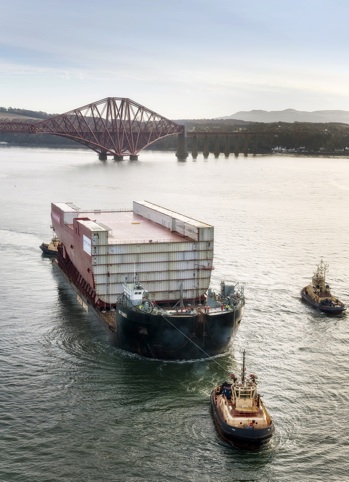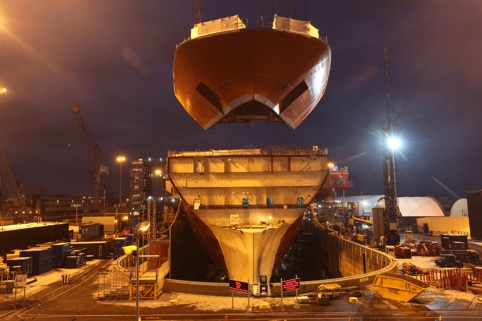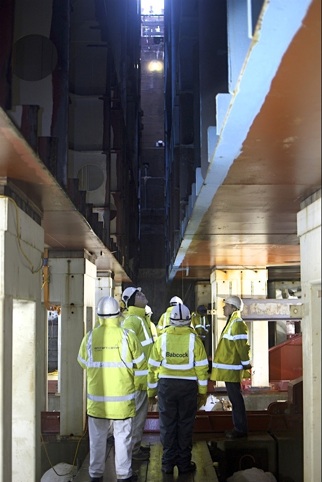It is now January 2013, the start of another significant year for the Aircraft Carrier Alliance (ACA) and the project to design, build and deliver into service two 65,000 tonne aircraft carriers for the Royal Navy.
We finished off 2012 with some significant events at Rosyth. Lower Block 04 (LB04) arrived by barge on Remembrance Sunday following its journey from Govan; the block had to take the long way round and travel south due to bad weather. This gave us a less time in the available tidal window to remove the sea fastenings, ballast the block and prepare for the float off operation. Had we missed that tidal window we would have had to wait around a month for suitable tides, and with Christmas approaching the impact could have been significant.

However, following some really hard work the barge and the block were prepared, and the float off operation went ahead to plan on the 16th November. The following day LB04 was docked down into position in the build dock separated from the remainder of the ship by the intermediate gate. The float off operation built on the lessons learned from previous operations and was carried out alongside the jetty where the sea bed had been suitably dredged. As well as dispensing with the requirements for extensive anchoring arrangements and dealing with tidal flows it also presents an ideal location for people like me to watch the operation without getting in the way! I was going to say without getting wet but as it rained heavily all day that wasn’t quite true. You can see video of the process here.
Before the two parts of the ship could be joined together the last few units making up the forward part of the ship were loaded on using the Goliath crane. The timing was perfect - we had invited a number of VIPs to visit Rosyth on the 21st November and while they were being briefed in the board room, outside the last part of the forward port sponson was being gently lowered into position, which rather distracted them from the presentation. In fact at one point we had to stop the presentation while everyone peered out of the window.
The upper part of the bow, including the mooring decks and anchor pockets, was lifted into position early one morning in December, during a suitable weather window. Again the view from the office window was spectacular as the unit, looking a bit like a flying saucer, descended from the dark sky into the glare of the flood lights while a flurry of snow fell around it.

To join the two parts of the aircraft carrier in the dock, the intermediate gate was removed and the forward part, all 20,000 plus tonnes of it, was skidded back about 18 metres to align with LB04. There have been several questions about why we chose to move the larger, heavier forward bit rather than moving LB04. The reason wasn’t that we just like a challenge, but that the forward part has a far larger extent of flat bottom and is thus much easier to jack up and skid.

The skidding operation took place on the 28th and 29th December with the intention, successfully achieved, of having the whole ship in place, brows and services reinstated so that it would all be ready for the workforce to return to after the Christmas and New Year break.
Skidding such a huge piece of structure is no mean feat, it is accomplished by jacking it up with numerous hydraulic jacks, lowering it onto PTFE slides and then using horizontal hydraulic rams to slowly move it back, adjusting to achieve alignment as necessary. The alignment between LB04 and the forward part of the ship is once again excellent which is something that all those involved in can be extremely proud of. You can see a time lapse of the process here.
https://www.youtube.com/watch?v=8RIW6enRBXI
Queen Elizabeth is now bigger than any ship in the history of the Royal Navy, and with outfitting on-board at an advanced state, we’ve got the first ever opportunity to hold an ACA event on-board. Therefore we have decided to hold this year’s management briefing in the Operations Room. This is a really exciting opportunity for the management team to get close up to what they have achieved and really celebrate the continuing success of the project. The briefing will be used to set the objectives for the next year, during which Queen Elizabeth will become structurally complete and setting the systems to work will really start to ramp up.




Collaboration to address viable solutions for VAWG database
<blockquote>address the lack of standardisation, coordination, and collaboration of gender disaggregated data intelligence across various regions,...